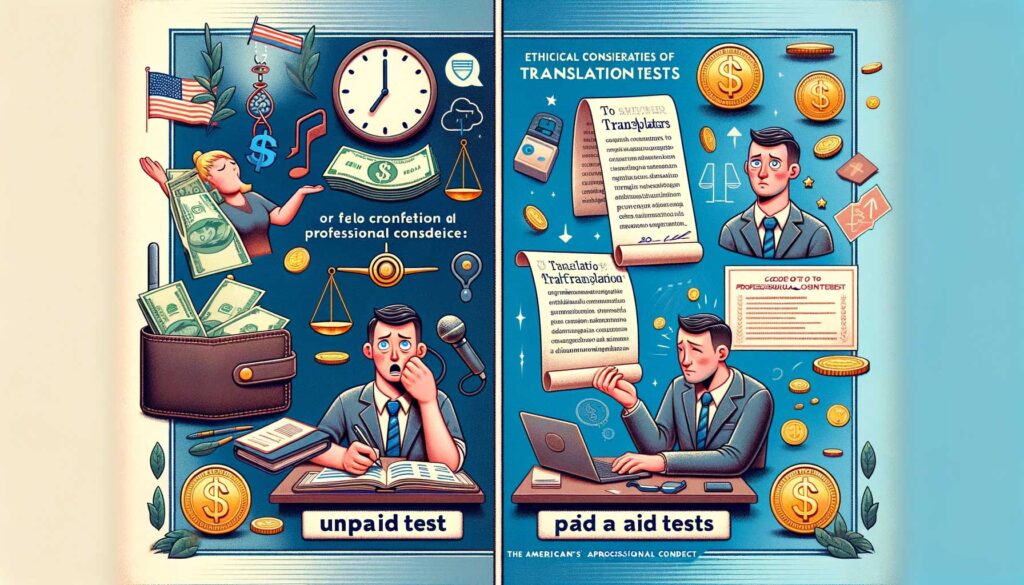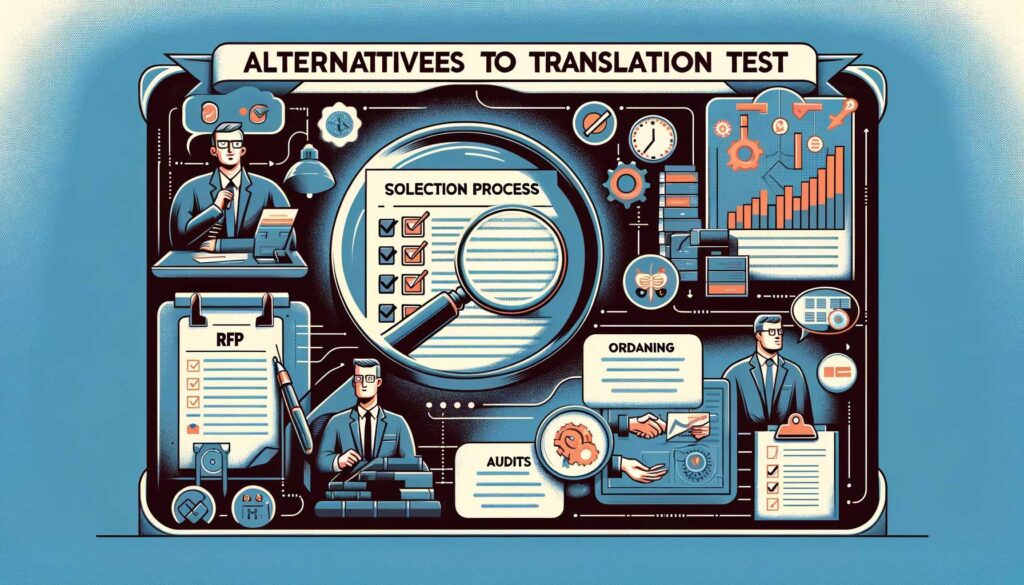Translation tests are given to translators to assess their skills. The use of these tests has been debated for quite a long time. There’s quite a bit of controversy surrounding the use of these tests.
In this article, we’ll discuss how these tests work both from the translator’s and the employer’s perspectives.
What are translation tests?
A translation test is a test given by a translation agency to assess the proficiency and suitability of a translator for a specific job or project.
Table of Contents
The Translator’s Perspective
Most translation tests are part of the hiring process. They’re given to assess the translation capabilities of job candidates.
The tests are given to job candidates for free, and the candidates are not paid for their time. Most of these tests vary from between 300 to 600 words, along with a witness statement. Many translation agencies give the tests and promise to send full feedback to the potential employee. However, some agencies never respond, while others can take up to several months (or longer) to email the feedback.
Another stunning fact is, why ask a translator to take a free test? Do other professions make the same request of new employees or freelancers? Do these professionals have to offer a free sample of their work? No, usually not. Would you ask a doctor for a free sample exam or an accountant for a free monthly expense report? Would you ask a builder to build you a free building to test his building abilities? No, you wouldn’t, and if you did, these professionals would rightly refuse such requests. So, why do translation agencies ask potential employees for a free sample of their work?
Some translation agencies offer to pay the translator for taking the test; however, most do not offer payment. In addition, tests for certifications (such as the American Translator’s Association Certification) require the translator to pay, as the test is to test and credential their own abilities.
How to Pass a Translation Test

We’ve put together some tips to help you score high on your next translation test:
1. Carefully Read the Instructions
The ability to follow instructions is an essential part of the test and translation work. So, from the first email right up to the test, carefully read and follow all instructions. The test is not only about testing your translation abilities; it’s also about checking to see if you can manage and meet deadlines. Missing a deadline for a translation test shows you’re unable to meet the translation agency’s deadlines.
2. Only Take the Test if You’re Translating into Your Native Language
Translators need to be excellent writers in the target languages they work with. They must also be aware of styles and trends in that language, whether the text is for a business email or an academic paper.
Few translators can translate effectively in both directions. So, look at your skills and determine which language best shows your writing abilities.
3. Don’t Translate Too Literally
This means don’t translate verbatim from the source content into the target language. The result is text that doesn’t work well for the native speaker of the target language.
Instead, consider transitions, sentence length, flow, and redundancies. It would be best if you strived to include all pertinent information from the source text; however, your sentences don’t have to match those in the source document. The finished translation should be a test of your writing abilities.
4. Do Your Research
Check the names of public figures, buildings, and organizations, and ensure that similar texts in the target language use the same phrasing.
You might want to use the site Google Translate, which is a helpful resource; however, it should only be used with caution. Remember, the tool doesn’t offer perfect translations every time.
5. Read Your Translation Several Times Before Submitting
While it may seem like overkill, it’s a good idea to read your translation over several times. You’ll be surprised at the number of errors and typos you find. You might also need to redo a sentence that isn’t translated in the best way possible. It does make a huge difference!
So, fix all errors and other issues before submitting the translation test to the translation agency.
6. Put Any Notes You May Have as Inserted Comments
Don’t put notes in the text within parentheses or highlight the text. This is confusing to the editors. This includes any notes on why you chose a specific term (if you believe this could be disputed), or requests for clarification, etc. Never guess.
The translation agency will be pleased to see that you’re working to create an accurate translation. But if the notes are in the text, they could be mistaken as part of the text. So, keep all notes outside the text to keep them from being confused as part of the translated text.
The Employer’s Perspective

Why do translation agencies give translation tests to translators? There are several reasons:
1. CVs: it is possible to hire the best translator based solely on their CV; however, CVs are primarily created to “sell” the translator to the agency. But that’s a problem because marketing skills are not a good indicator of a translator’s professional competence. Sure, their CV is beautifully done; however, what if the person is a gifted translator, but their CV is unattractive? Hiring a translator based on their CV doesn’t always mean hiring the best translator.
2. References: it is possible to review a translator’s references, but these can also be problematic. For instance, there’s no guarantee the person who gave the reference had a professional relationship with the translator. It’s also impossible to determine the quality of translation work provided to the person who offered their reference.
3. Translation portfolios: are often provided by translators; however, these can also cause issues and concerns. One of these is doubts that the translators did the work themselves. Again, anyone could have done the translation work, or it could have been downloaded from the web. They may also share a previous client’s content without their permission, which is a violation of confidentiality. These violations can cause serious problems for the translation agency that provided the work.
So, if a translation agency doesn’t know the translator, the translation test is the best way to determine their translation abilities. In addition, translation companies can reduce the costs of hiring and decrease their risk of working with new translators.
Translation agencies do use translation tests to assess potential translators during the recruitment process. However, there are some downsides to these tests.
Are translation tests given for each specialization?
No. Again, if the translation agency is small, they may not have enough in-house proofreaders who are free to evaluate the translation test. In addition, they may not have proofreaders who can manage certain language combinations.
It’s also challenging to know who does the translation test because they are sent to the translator. The tests are often returned via email, so there’s no way to verify who took the test. A translator can outsource the test.
Additional issues can include the following:
Longer tests are free translation jobs. Some translation agencies ask the translator to take the test. If they say yes, the translator may be surprised with a test over 3,000 words. It’s happened!
Another issue is that there’s no guarantee the translator will be hired after the test. Once they’ve passed the translation test, they may not get hired. It all depends on whether their language combination or specialization is required.
On the other hand, translation agencies will give a translation test for larger projects. Their client may want to see a sample of the translator’s work in that case.
Types of Translation Tests
Occasionally, a translation agency may request a translator to take a translation test. Different types of translation tests are commonly used in the industry.
Sample Tests
These tests are usually between 200-350 words, and the agency may include reference materials for the translator to refer to during the test. Sample tests create an artificial environment that’s close to an actual translation project. These tests are usually paid.
Short free Tests
These are similar to sample tests in that they are about 200-350 words long. These tests are usually unpaid. Should you take one? It depends. If the prospect of getting work is pretty good, then taking a free test may be a good option. Another way to look at this is that the free test is also good practice for what it would be like working for a client. If you decide to take a free test, make sure the test is no longer than 200-350 words. This won’t be a waste of your time, and you can view it as a learning experience even if you don’t get the position.
Long Tests
Most translators are strongly opposed to long tests. As the name intimates, a long test can be anywhere from 1,000 words long or longer. They can take from 2-10 hours to complete. If the test is paid, there’s no problem. Translation agencies that pay for these tests are serious about hiring someone, and you get paid for your time.
On the other hand, scammers also use long tests. In this case, the scammer may have been hired by a client to translate a long text, such as a medical text. The scammer agrees to take the work; however, instead of doing the work themselves, they break the text up into 1,000 words (or larger sections) and pose as an agency hiring translators. They give the text sections to different translators to work on. The work is done for free. In the end, the scammer has an excellently translated text, and the translators who worked on the project are not paid and are not hired for a job. Unfortunately, this is a common occurrence in the translation business.
Ethical Considerations

Translation tests can be helpful to both the translator and the translation agency. However, there is a strong movement within the industry to move away from unpaid tests. The reason is that it’s possible to take the test and not get the job. The translator ends up wasting time; they have nothing to show for the work they put in on a short test.
Translators have not worked hard to earn their certifications and qualifications only to work for free. Many of them decide to refuse all requests for unpaid translation tests. The American Translators Association’s Code of Professional Conduct and Business Practices says, “As an employer or contractor of translators and/or interpreters, …I will not require translators or interpreters to do unpaid work for the prospect of a paid assignment.” Agencies that belong to this association are prohibited from asking translators to take an unpaid test.
So, what does this mean? Reputable translation companies will pay their translators to take a test. Translators then receive pay for their time.
In addition, professional translators usually provide samples of their work and references. So, unpaid tests are generally not necessary.
Translators face the same issue as they do with scammers. Some agencies will break a larger text into smaller sections and use these sections as unpaid tests. The agency then looks for translators who need work and asks them to translate a section of the larger text. Ultimately, the agency gets the text translated for free, while the translators go unpaid.
As a translator, should you take an unpaid test? The answer depends. If you’re starting as a professional translator and need to create a portfolio, you may want to consider doing the free translation if there’s a reasonable prospect of getting a job.
If you choose to do an unpaid test, here are some tips to ensure you avoid scammers:
Research the client: check to see if this is a reputable client. Ask about the guarantees they can give that you’ll receive paid work once you’ve done the unpaid test. In addition, check to see how many years the company has been in the translation market. If they’ve been around for a long time, chances are good they are a professional, reputable agency. Search for reviews about the company and Google its phone number, email address, and sender’s name (look for a profile on LinkedIn). You can also find feedback on ProZ, an online community and workplace for professional translators and translation agencies.
Limit the time you work for free: unpaid translation tests that are 300 words or less should be in your area(s) of specialization. Avoid being pressured into taking an unpaid translation test. If an agency requests you for a fast turnaround on a free translation test, it usually means you won’t be paid for the work, and there’s no job for you.
Agree to rates & payment terms: before taking an unpaid translation test, agree to rates and payment terms. That way, you won’t have to waste time taking the unpaid test if the agency doesn’t agree with your terms.
Alternatives to Translation Tests

There are, fortunately, alternatives to translation tests. In this section, we’ll discuss the different alternatives a translation agency may want to consider instead of translation tests.
1. Robust Selection Process
A robust, thorough selection process can determine whether a translator has the qualifications needed by a translation agency. For instance, translators who have a certificate show they were audited and were found to have a documented, repeatable process for their work.
2. Responses to an RFP
Responses to an RFP can also determine how a translator will work once they’re hired. In this case, it’s essential to follow up with references to gain insights about how the translator works.
Clients usually request samples of the translator’s CV, too, or request their references. The information can help a translation agency determine if the translator is the right fit and has the required subject matter expertise and other competencies needed on the job.
Once the translator has been hired, ongoing maintenance steps can be implemented, including on-site translator audits, the use of key performance indicators, and regular reviews of their work. In addition, carrying out random spot-checks is another way to validate the quality of their work.
A translation test offers only a small bit of information when evaluating the talents and abilities of a translator. However, combining these alternative evaluation methods can provide more insight into the translator’s work and behaviour on the job.
Challenges in Test Design
The problem with many translation tests is that they are not based on a specific topic. A general test is usually not helpful for the translation company or the translator.
Tests that are too long and unpaid are not suitable for the translator especially if the test is unpaid. A test that’s 1,000 words or more is a waste of time for the translator and costs more for the agency to have proofread. In addition, some agencies use proofreaders who do translation work. This is an underservice to the agency and the translator (who may have to explain word choices, etc.).
What makes a good translation test design?
How can an effective test be made that works for the agency and the translator? We have some suggestions that can make for a better test.
1. Specialized tests: the text for each test should be on a specific topic. For instance, law, medicine, etc.
2. Keep the test short: translation tests should be no longer than 300 words. Otherwise, it’s a waste of time (and money) for the translator and the agency.
3. Equality: there should be one test for each topic an agency works with. For example, one law text for translators who specialize in legal translation, a test for medical translators, etc. One test per topic is fair, and the person who proofreads each test should also have specialized knowledge on the specific subject.
4. Translation brief: some background should be given about the text that’s being translated in the test. What will the text be used for? Who is the target audience? This information can help the translator immensely.
5. Feedback: even if the translator will not be hired for a job, it’s a good idea to allow them to review the document so they can learn from their experience.
The Future of Translation Tests
Translation tests will remain a staple of translation agencies for the foreseeable future. Tests remain one of the most reliable methods of testing the abilities of a translator and evaluating whether they’re a good fit for the agency. In addition, short, unpaid tests will be the norm rather than longer tests, though some agencies are moving toward paying a nominal fee to translators who take their tests.
The key is to ensure that translation tests are specifically designed for specialized topics and any other specialities handled by the translation agency. If an agency can afford to pay a fee to the translator, this should be done. It shows good faith and compensates the translator for their time.
Trends in Translation testing
Highlight any emerging trends or changes in how translation tests are used in the industry
Discuss how technology, such as CAT tools or AI is influencing testing methods
Test preparation resources
Guide translators on how to prepare for translation tests, including recommended resources and study materials.
Conclusion
Translation tests are widely used within the translation industry to assess a translator’s skills and whether or not they are a good fit for the agency. However, the tests have caused controversy from the translator’s and the employer’s perspectives.
While translators often take the tests for free, the feedback process is poor and can take quite a long time. Even so, translation agencies continue to use translation tests because there are limitations to relying only on CVs, references, and portfolios to evaluate translators.
The future of translation tests, for now, is expected to focus on short tests that are unpaid. Translation agencies will move toward translation tests that focus on specific topics, while some agencies will move to compensate translators for their time.
It’s important to understand the different perspectives (translators vs employers) and design improved tests that are more equal and combined with a robust evaluation process.
What are the ways of testing a translation?
There are five ways to test a translation:
- Comparison with the source text
- Translation into the source language (back translation)
- Comprehension checks
- Naturalness and readability testing
- Consistency checks
What are the 4 types of translation studies?
The four types of translation studies include:
- Literary translation
- Professional translation
- Technical translation
- Administrative translation
How do I prepare for a translation test?
See the section on “How to Prepare for a Translation Text.” Here we summarize the main points:
1. Carefully read all instructions.
2. Only take the test if you translate into your native language.
3. Don’t translate too literally.
4. Do your research.
5. Read your translation several times before submitting.
6. Put any notes you make as inserted comments (not placed directly into the translation).
Read More:
